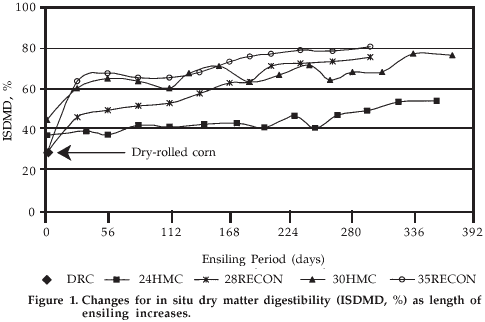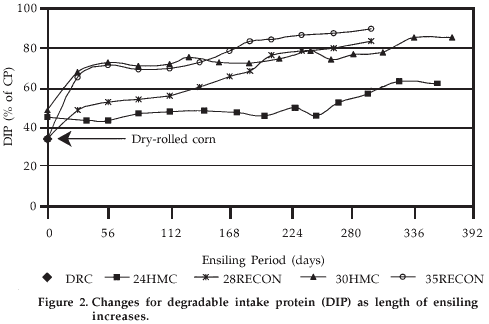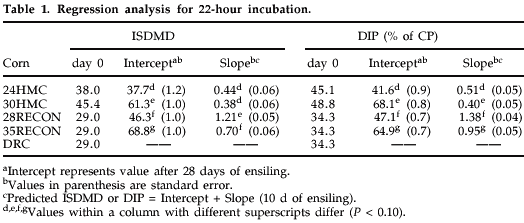Effects of Corn Moisture and Length of Ensiling on Dry Matter Digestibility and Rumen Degradable Protein
Published: April 8, 2009
By: Joshua R. Benton, Terry J. Klopfenstein and Galen E. Erickson - University of Nebraska Cooperative Extension - Nebraska Beef Cattle Report (File MP83-A), Institute of Agriculture and Natural Resources
An in situ trial was conducted to evaluate effects of corn moisture and length of ensiling on dry matter digestibility (ISDMD) and degradable intake protein (DIP). Corn treatments consisted of dry-rolled, high-moisture, and reconstituted dry corn. Corn samples were incubated in situ for 22 hours and ISDMD (%) and DIP (% of CP) values were calculated. Both highmoisture and reconstituted corn had higher ISDMD and DIP values than dry-rolled corn. Dry matter digestibility and degradable intake protein increased for high-moisture and reconstituted corn when either moisture or length of ensiling was increased.
Introduction
Research has shown that storing and feeding high-moisture corn (HMC) improves feed conversion 8% compared to feeding dry-rolled corn in feedlot diets containing byproducts. It is not clear if the benefits are from increased moisture, the effects of early harvesting on the maturity of the corn kernel, or fermentation that occurs during the ensiling period. Previous Nebraska research has shown that a longer ensiling period, along with intensive processing and higher corn moisture, leads to an increase in dry matter and starch digestibility. The increase in ruminal digestion has been shown to increase the degradable intake protein (DIP) requirement. Degradable intake protein is the fraction of crude protein protein available to the microbial population. When the increased DIP requirements are met, cattle performance is improved.
In feedlots, acidosis causes physiological and biochemical stresses in cattle when they consume fermentable carbohydrates at a rapid rate. Ruminal pH drops below 5.6 and feed intake is reduced. Previous research shows that high-moisture corn is digested rapidly in the rumen and this can lead to acidosis (1986 Nebraska Beef Report, pp. 13-14). Therefore, when measuring dry matter or starch digestibility and protein degradability with in situ methods, animal diets must be considered. The animals should be on a finishing diet so that any effect of rumen pH on microbial digestion will be accounted for during in situ incubation. Particle size of in situ samples also may affect estimates of dry matter or starch digestibility and protein degradability.
The objectives of this study were to evaluate the effects of corn moisture and length of ensiling on in situ estimations of dry matter digestibility and degradable intake protein in cattle fed a finishing diet.
Procedure
Corn Samples
High-moisture corn was harvested at two times in September at 30% or 24% moisture (30HMC or 24HMC), coarsely rolled and stored in silo bags. Field-dried corn was harvested in mid-October. In late November, some of the dry corn was coarsely rolled, reconstituted to 28% or 35% moisture (28RECON or 35RECON), and then stored in silo bags. The remaining dry corn was stored dry and coarsely rolled at time of feeding (DRC). These five corn treatments were fed in a finishing trial from May to September the following year. All corn was of the same hybrid and grown in two University of Nebraska fields. All corn (except DRC) was sampled every 28 days throughout the ensiling period. The 30HMC and 24HMC treatments were ensiled for 372 and 358 days, respectively. The two reconstituted corn (RECON) treatments were both ensiled for 298 days. These corns were used in a feeding trial (2005 Nebraska Beef Report, pp. 28-30).
In Situ Procedure
Three ruminally cannulated steers were housed in individual pens and offered a diet that consisted of 68.5% DRC, 20% wet corn gluten feed, 7.5% alfalfa hay, and 4% dry supplement (DM basis). Rumensin® and Tylan® were included at 29 and 10 g/ton of diet DM, respectively. Dry matter digestibility and rumen degradability of protein were estimated for the five corn treatments by incubating duplicate 10 × 20 cm dacron bags filled with 5.0 g of corn in the rumen of each steer. The corn samples were ground through a Thomas-Wiley mill to produce a simulated masticate grind to have a particle size similar to masticated dry rolled corn (2004 Nebraska Beef Report, pp. 54-57). Samples were incubated for 75% of the mean retention time. Mean retention time is equal to the inverse of rate of passage using a passage rate of 3.44 %/hour for all samples, therefore samples were incubated for 22 hours. After incubation, samples were rinsed in a washing machine with 0.395 L of 39oC water per in situ bag. There were five rinses consisting of one minute agitation and two minute spin each. Bags were then dried in a 60oC forced-air oven for 18-24 hours, removed, weighed, and residues were analyzed for nitrogen.
Calculations
The residue weight of each sample was calculated by subtracting the original bag weight from the residue and bag weight obtained after drying. The ISDMD was calculated by dividing the residue weight by the original sample weight before incubation. The DIP was calculated by using the following equation: DIP (% of CP) = {1 - [(Residue weight × Residue %CP) / (Sample weight × Sample %CP)]} × 100.
The ISDMD and DIP values were regressed over ensiling days. From the regression equations (y = mx + b) given, the predicted ISDMD or DIP can be calculated. The intercept b) represents the ISDMD or DIP after the first 28 days of ensiling and the slope (m) represents changes in ISDMD of DIP over time of ensiling after 28 days where x is equal to length of ensiling period in 10-day increments.
Results
Figures 1 and 2 show how the values for ISDMD and DIP for each corn changed over the ensiling period. When moisture was increased for HMC (from 24% to 30%) and RECON (from 28% to 35%), total ISDMD and DIP increased (P < 0.10). The greatest changes in ISDMD and DIP occurred in the first 28 days of ensiling, with the greatest increase for 35RECON followed by 30HMC and then 28RECON (P < 0.10). Compared to DRC, both HMC and RECON had greater total ISDMD and DIP. With increased moisture, ISDMD and DIP both increased and both continued to increase with more days of ensiling. The values presented are relative values which may be influenced by laboratory procedures. The values will give relative differences between the treatments and cannot be assumed to be the absolute values or differences.


Figures 1 and 2 show that after large changes in the first 28 days, further changes appeared to be linear. Therefore, the values after 28 days were regressed over time (Table 1). The slopes of RECON were greater (P < 0.10) than HMC. The slope of 24HMC was not different (P > 0.10) from 30HMC for ISDMD, while the slope of 24HMC was greater (P < 0.10) than 30HMC for DIP. The slope of 28RECON was greater (P < 0.10) than 35RECON for ISDMD and DIP.

As mentioned earlier, it has been shown that cattle performance is improved when increased requirements for degradable intake protein, due to increased ruminal digestion, are met. This study suggests that cattle performance may be improved by ensiling higher moisture corn resulting in increasing ISDMD and DIP of that corn. Reconstituted dry corn resulted in similar increases in ISDMD and DIP compared to HMC and these results would suggest that the changes in ISDMD and DIP are due to the effects of moisture and ensiling. There may be some initial improvement in the feeding value for HMC due to the effects of early harvesting, but it appears that after 28 to 56 days of ensiling, RECON and HMC are equivalent.
Based on this research, there appear to be two distinct phases to the changes that occur over time of ensiling. The first change occurs in the first 28 days of ensiling where there are significant increases in the ISDMD and DIP values of the corn. The second change occurs gradually after 28 days throughout the ensiling period where there are slight increases in the ISDMD and DIP values. In conclusion, as moisture and length of ensiling increase, the estimated values for dry matter digestibility and protein degradability will be increased.
Authors: Joshua R. Benton (graduate student), Terry J. Klopfenstein (professor),and Galen E. Erickson (assistant professor, Animal Science, Lincoln)
University of Nebraska Cooperative Extension, Institute of Agriculture and Natural Resources
Nebraska Beef Cattle Report (File MP83A)
University of Nebraska Cooperative Extension, Institute of Agriculture and Natural Resources
Nebraska Beef Cattle Report (File MP83A)
Related topics
Join to be able to comment.
Once you join Engormix, you will be able to participate in all content and forums.
* Required information
Would you like to discuss another topic? Create a new post to engage with experts in the community.
Create a post



.jpg&w=3840&q=75)